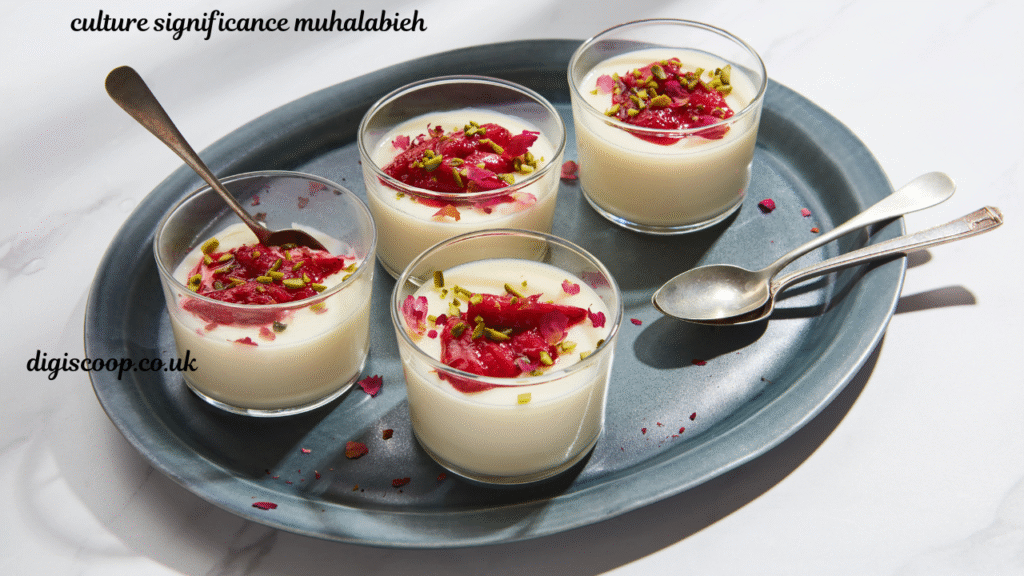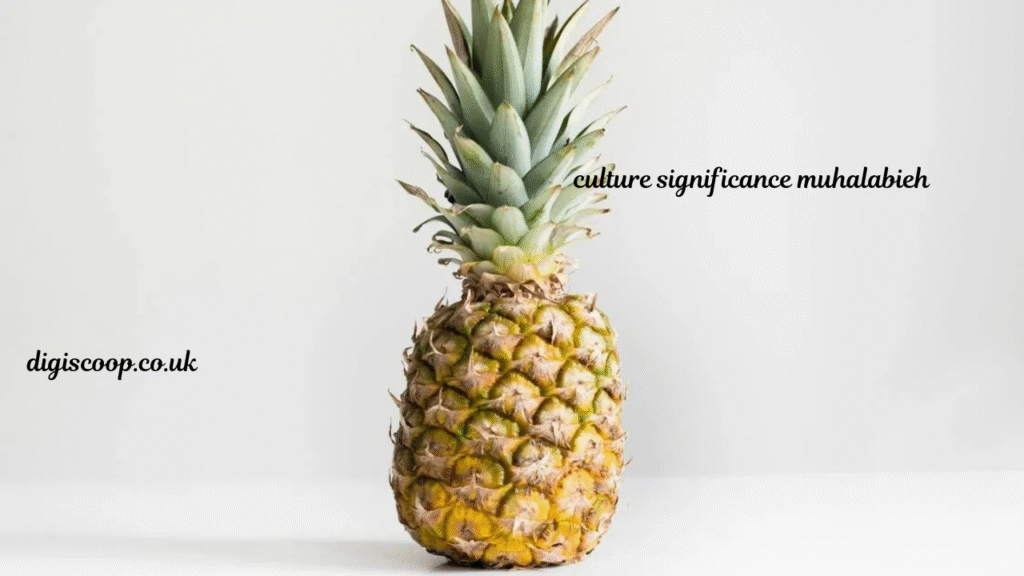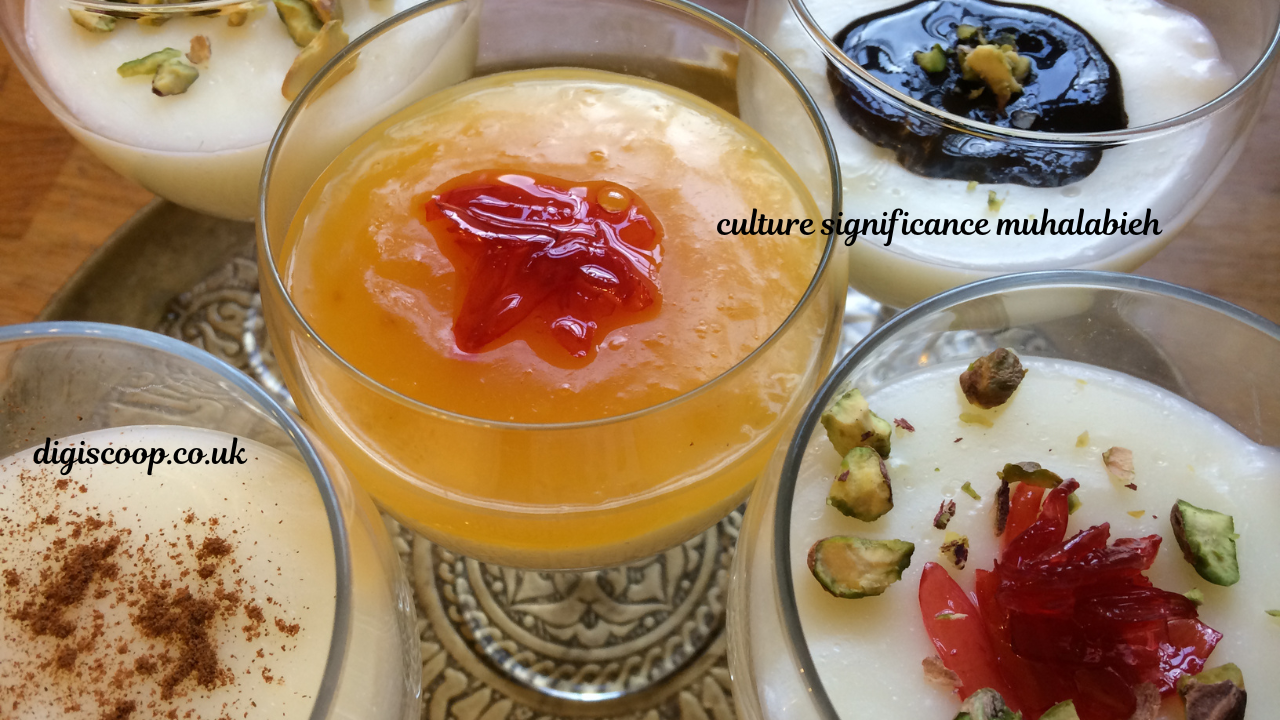Introduction: The Essence of Muhalabieh in Cultural Identity
The phrase “culture significance muhalabieh“ may seem simple at first glance, but beneath it lies a tapestry of history, tradition, memory, and identity. Muhalabieh, a delicate milk-based dessert that traces its origins back to the Middle East, is more than just a sweet treat served at the end of a meal. It is a cultural artifact, a symbol of familial ties, regional pride, and shared celebration. As with many traditional foods, its importance transcends flavor and presentation—it’s about legacy, emotion, and belonging.
Origins of Muhalabieh: A Historic Culinary Heritage

To understand the culture significance muhalabieh, we must start with its roots. Muhalabieh is believed to have originated during the Umayyad Caliphate in the 7th century, named after an Arab general named Al-Muhallab ibn Abi Sufra, who reportedly fell in love with the dessert. Over centuries, this simple concoction of milk, sugar, rice flour (or cornstarch), and fragrant additions like rosewater or orange blossom water evolved through regional influences and culinary adaptations.
Today, variations of muhalabieh can be found across Lebanon, Syria, Palestine, Jordan, Turkey, and even parts of North Africa and the Gulf, often reflecting each culture’s distinctive touch—be it with toppings of pistachios, coconut, caramel, or date syrup. This wide geographical embrace only reinforces its importance as a unifying symbol across many Arab and Mediterranean cultures.
A Symbol of Hospitality and Celebration

One cannot overlook the culture significance muhalabieh when exploring the social fabric of Middle Eastern hospitality. Traditionally served to guests during family gatherings, weddings, and religious festivals like Eid or Ramadan, muhalabieh represents generosity, warmth, and communal joy. The act of serving this dessert is steeped in a value system that prioritizes kinship, respect, and celebration of presence.
In homes where elaborate meals are served, the finale of muhalabieh brings not just a soothing close to the dining experience but also a sense of nostalgia and emotional warmth. Its light texture and gentle flavor allow it to be appreciated even after a heavy feast, further solidifying its place as a staple dessert in celebratory menus.
Cultural Transmission Through Generations

The culture significance muhalabieh extends beyond its taste and presentation into the realm of cultural education and family bonding. Across many households, the preparation of muhalabieh is a family affair. Mothers and grandmothers pass down their secret ratios, preferred ingredients, and ritualistic steps to daughters and sons, not just teaching a recipe but also conveying the values associated with patience, care, and sharing.
In this way, muhalabieh becomes a medium of cultural preservation. As younger generations move abroad or grow up in multicultural environments, making muhalabieh serves as an act of reconnecting with their roots. It’s an edible link to grandparents, a reminder of childhood gatherings, and an assertion of identity in foreign lands.
Spiritual and Seasonal Associations
Another layer to the culture significance muhalabieh is its association with specific religious or seasonal events. Particularly during the month of Ramadan, muhalabieh finds a central place on the iftar table. After a day of fasting, this gentle dessert offers comfort, hydration, and spiritual closure to a day of restraint.
Its simplicity is meaningful—humble ingredients, devoid of extravagance, are transformed into something delicious and soothing. This transformation itself is reflective of the Islamic value of moderation and the blessings found in simplicity. Additionally, during the hot summer months in the Middle East, its chilled form becomes an ideal refreshment, highlighting its seasonal significance in daily lives.
Regional Interpretations and Identity
While the base of muhalabieh remains consistent, the culture significance muhalabieh is also evident in how different regions add their own identity to the dish. In Lebanon, it might be topped with a vibrant layer of rose syrup and crushed pistachios. In Turkey, it might carry traces of mastic or even be baked into a pudding-like dessert. Palestinian homes may serve it with date molasses, while in Gulf countries, saffron and cardamom might make an appearance.
These regional flourishes are not just aesthetic or flavor-based; they are statements of identity, expressions of belonging, and showcases of local agriculture and preferences. Muhalabieh becomes a canvas upon which each culture paints its distinct flavor palette, while still holding onto a shared heritage.
Muhalabieh in Modern Diaspora: A Cultural Anchor
For those who live in the diaspora, far from their ancestral lands, the culture significance muhalabieh takes on even deeper resonance. As communities navigate life in new environments, traditional dishes like muhalabieh become vital in maintaining cultural identity. Preparing and sharing muhalabieh during holidays or cultural events allows immigrants to celebrate their heritage, introduce others to their traditions, and instill pride in younger generations.
In multicultural cities across Europe, North America, and Asia, one can now find muhalabieh in Middle Eastern restaurants, food trucks, and cultural festivals. It serves as a soft ambassador of its origin cultures—approachable, flavorful, and rich with meaning. For second and third-generation immigrants, making muhalabieh is not just about dessert—it’s about reclaiming and preserving a piece of home.
Culinary Art and Aesthetic Presentation
Part of the culture significance muhalabieh lies in its aesthetic. Traditionally served in glass cups or shallow bowls, the dessert is often decorated with intricate designs made from nuts, shredded coconut, edible flowers, or colorful syrups. This emphasis on presentation is deeply rooted in the Middle Eastern cultural appreciation for beauty, refinement, and detail.
In recent years, culinary artists and home chefs alike have begun to elevate the presentation of muhalabieh with modern techniques—layering it with fruit compotes, sculpting nut designs, or pairing it with unexpected flavors. Despite these innovations, the soul of the dish remains unchanged, continuing to honor its cultural roots.
Emotional and Psychological Dimensions
Finally, the culture significance muhalabieh also encompasses emotional and psychological comfort. The dessert is often one of the first sweets introduced to children, given its soft texture and mild flavor. As a result, it becomes associated with care, nurturing, and innocence. For adults, it recalls memories of family dinners, grandparents’ homes, and festive occasions.
There’s a reason why people return to familiar foods during times of emotional need. Muhalabieh, in its gentle sweetness and comforting texture, offers a form of edible therapy—a reminder that cultural traditions can soothe the soul as much as the body.
Conclusion: A Dessert that Tells Stories
To understand the culture significance muhalabieh is to appreciate how food functions as a bridge between past and present, personal and communal, local and global. Muhalabieh is more than a dessert—it is a symbol of resilience, identity, hospitality, and shared memory.
Across generations and continents, it continues to be made, shared, and cherished—not only because it tastes good, but because it feels meaningful. In a world where identities are often challenged or diluted, muhalabieh remains a quiet yet powerful statement of cultural pride.
Also Read : When Was Cruzado Launched in Portugal, ?? — A Historical and Economic Insight







